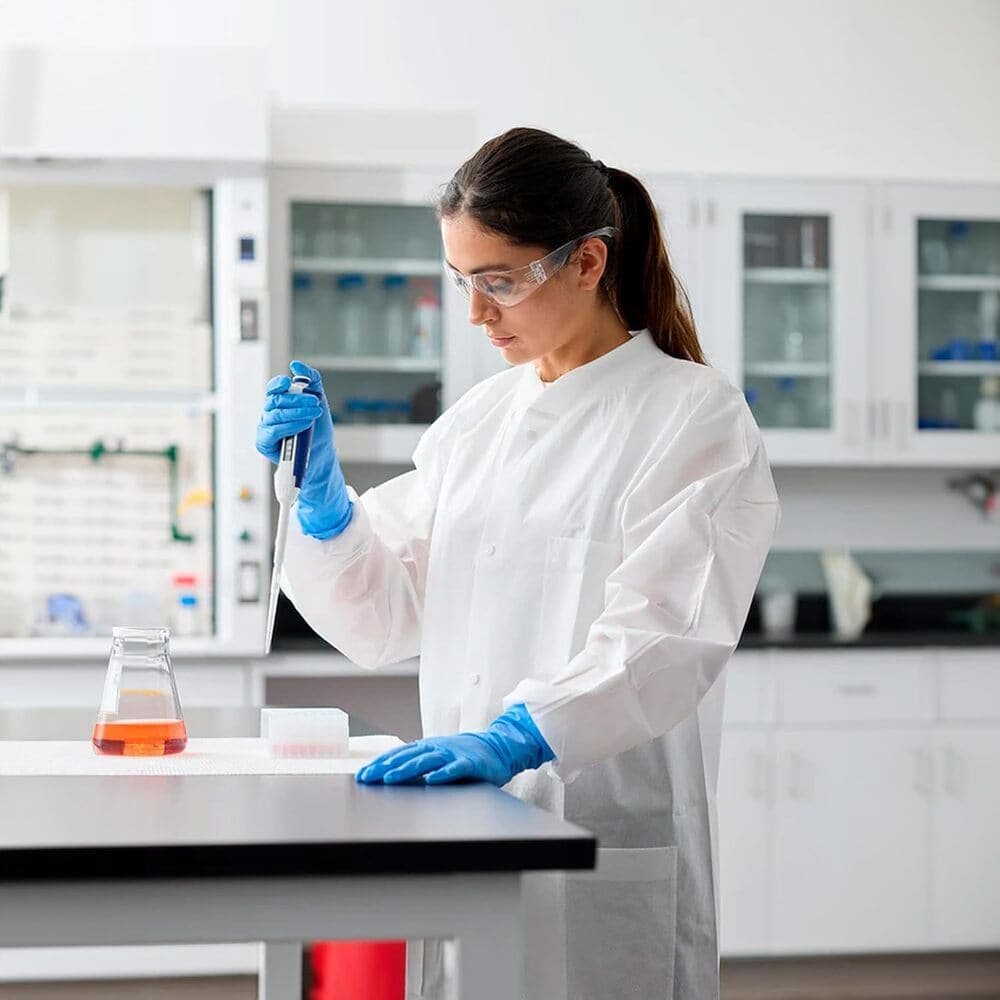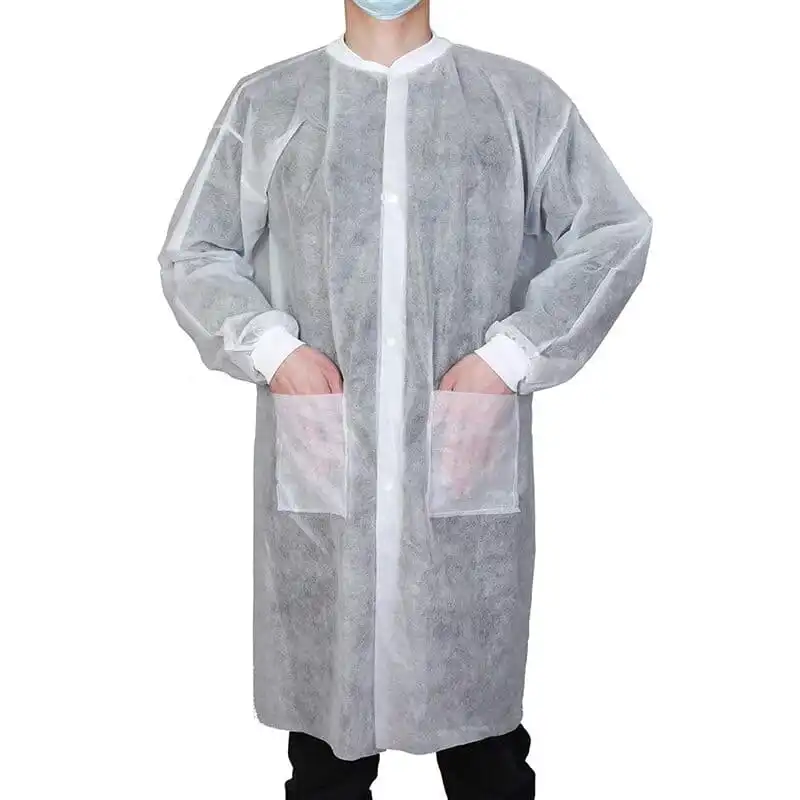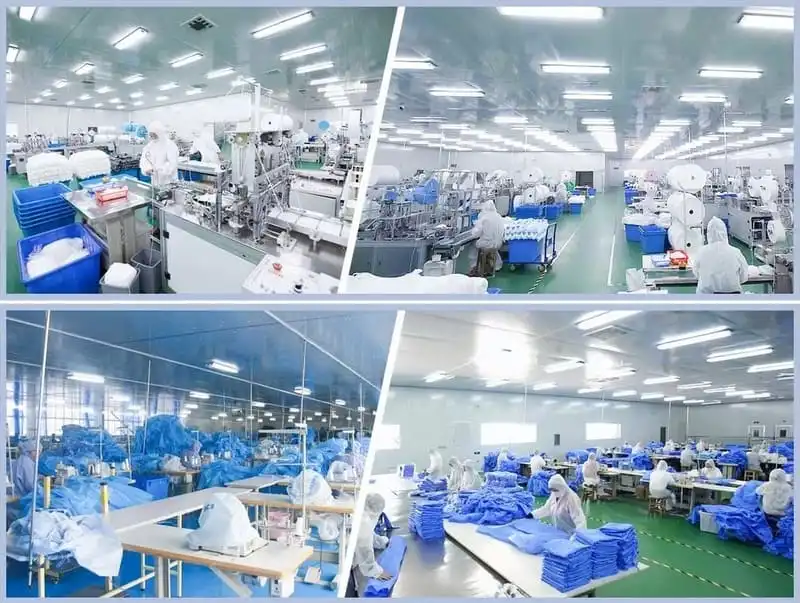Table of Contents
Disposable lab coats are an essential part of protective clothing in various industries-from healthcare to research labs and from food production to manufacturing. These disposable coats provide a convenient and effective protective solution for workers and offer prevention against contamination in a hygienic setting. Unlike conventional white coats which require constant laundering, disposable lab coats are designed to be a single-use, no-wash garment thus minimizing the risk of contaminating and cross-contaminating. This article will elaborate on the main benefits, applications, and selection considerations to help you choose the best disposable lab coats.
Key Purposes of Disposable Lab Coats

Provide Protection From Hazards
Protection From Contaminants
Disposable laboratory coats act as a protective barrier between the user and hazardous materials such as chemicals, biological agents, and bodily fluids, which may contact skin or contaminate personal clothing.
Prevention of Cross-Contamination
By wearing a disposable lab coat, professionals can minimize the risk of transferring contaminants from one area to another. After use, these coats are discarded, reducing the chances of spreading pathogens or chemicals outside the laboratory environment.

Hygiene and Cleanliness
Convenience of Use of Disposable Items:
Disposable lab coats are designed for one-time use, significantly enhancing hygiene compared to traditional lab coats requiring laundering. This feature is particularly crucial in environments where cleanliness is paramount, such as hospitals and research labs.
Reduced Probability of Infection:
Disposable lab coats lessen the transmission of infections in healthcare because they doom any potential contaminants to death through proper disposal following their business.
Cost-Effectiveness
Lower Maintenance Expenses:
Some see disposables as costly, but in the long run, they save laundries some money and some time maintaining clean lab coats for disposal.
Quality is Consistent:
Each disposable lab gown is new and made from high-quality materials. Unlike reusable coats that may degrade over time, disposables maintain their protective qualities with each use.
Practical and Efficient
User-Friendly:
Disposable doctor coats are relatively thin and are rather easily thrown on and off, making it easy to transition quickly between tasks or sections within facilities; mere wear simplifies workflow in busy environments.
Variety for Specific Needs:
Disposable laboratory coats exist in so many models and materials, from those meant for everyday laboratory work to those that serve more specialized environments like cleanrooms or pharmaceutical production.
In summary, disposable lab coats play a crucial role in maintaining safety and hygiene in labs and healthcare settings. Their ability to provide an effective barrier against hazards while being convenient and cost-effective makes them an essential component of personal protective equipment (PPE).
Applications of Disposable Lab Gowns
Disposable lab coats are widely used across various industries for their protective qualities and convenience. Here are the primary applications:
Laboratory Work
Lab coat is a type of disposable protective gear worn in research laboratories, academic institutions, and industrial settings where hazardous materials are present. It is used as a barrier against spills and splashes during experiments and procedures.
Healthcare Facilities
Hospitals, clinics, and related medical environments are also using disposable lab gowns to avoid cross-contamination between the patient and healthcare worker. The personnel can minimize the chances of transmitting infections through the use of lab coats and maintain sterility.
Cleanrooms
In those industries that require strict contamination control, from semiconductor manufacturing to drug production and biotechnology, their ability to maintain cleanliness while protecting sensitive processes from external contaminants makes disposable lab jackets a first line of defense.
Pharmaceutical Industry
In the pharmaceutical industry, disposable laboratory gowns are tremendously important, preventing contamination of a product during production and testing and thus fulfilling Good Manufacturing Practice (GMP) guidelines.
Food Industry
In food processing plants, laboratory coats are an indispensable tool in fulfilling hygiene standards and preventing food product contamination via workers’ clothing- this application bears extreme importance for food safety assurance and health regulation compliance.
Chemical Manufacturing
In chemical manufacturing, wearing a disposable lab coat offers protection from splashes that could pose extremely great risks to workers who deal with hazardous materials. As they are disposable, this takes care of any problems regarding infection, thus creating a very convenient and safe choice for these workers.
The versatility of disposable lab coats makes them an integral part of personal protective equipment (PPE) across multiple sectors. Their ability to provide effective protection while being convenient and cost-effective contributes significantly to workplace safety and hygiene.
How to Choose the Right Disposable Laboratory Coat?
Materials of Disposable Lab Coat
Different materials offer different levels of protection and comfort. Some options include the following:

Polypropylene is an option for lightweight and breathable protection for nonhazardous environments, such as a medical office or food processing site.

SMS lab coats, constructed with three layers of specialized polypropylene material, offer superior resistance against tears and fluid penetration while maintaining breathability, making them an ideal choice for laboratory and cleanroom environments.

Microporous Film – lightweight, water-resistant, and breathable – fits sterilizable environments, such as hospitals.

Tyvek is a high-density polyethylene material that offers superior protection against particles and liquids and, often, in applications involving hazardous settings.
Sizing and Fit
Selection of the right size is crucial to ensure comfort and performance. The sleeves of the lab coat should allow complete freedom of arm movement, while the body should give adequate cover. Sizes generally range from small to 5XL. The coat should be tight enough not to be baggy, yet not so tight as to restrict movement.
Additional Features
Pockets: Useful to hold various tools or notepads.
Knit Cuffs and Collars: These improve the fit and help keep contaminants out of the coat.
Front Closure Types: If you want a coat for quick access, snap closure is best. Velcro would allow some adjustments, and zippers would keep it firmly closed.
Comfort and Breathability
Lightweight materials are preferred for long-term wear in terms of providing comfort, though knitted wrists add to comfort even more as they provide a snug fit.
Intended Use
Consider the specific environment where the lab coat will be used:
For general laboratory work, a basic polypropylene lab coat might be enough to provide protection again common dust. In cleanrooms or pharmaceutical settings, choose a microporous or Tyvek coat for enhanced protection. In healthcare settings, ensure the coat meets relevant safety standards to protect against biological contaminants.
By evaluating these factors—material, level of protection, size, additional features, comfort, and intended use—you can select the most appropriate disposable lab coat for your needs. This careful consideration will help maintain safety standards while ensuring a comfortable working environment.
Tips for Sourcing Lab Coats
Always remember to keep safety, comfort, and compliance in mind while sourcing lab jackets from different suppliers.
1. Overview Your Specific Needs
Before contacting suppliers, list your requirements.
Intended Use- Find out if the lab coats are being used in health care, laboratories, clean rooms, or other applications. Different purposes could require different materials and levels of protection.
Material Requirements- Depending on various hazards, you might have to use the likes of polypropylene for basic needs and Tyvek when higher durability and greater chemical resistance are needed.
2. Reputation of Supplier
Choose a supplier who enjoys an excellent reputation in the industry.
Background: A good supplier will have experience and capability in supplying disposable PPE to various industries.
Customer Reviews: Search for customer feedback and testimonials to see, if any, the quality of products and support the supplier provides.
3. Evaluate Products
Quality should never be compromised while selecting one-time-use lab coats.
Durability: Ensure that the lab coats will be manufactured from high-quality materials that can withstand contingent working conditions without tearing or shearing.
Level of Protection: Ensure that your lab coats are certified by the relevant safety standards applicable to your industry, such as ASTM or ISO certification to indicate the respective capacities and resistant potentials to chemicals and biological agents.
4. Size and Fit Considerations
An appropriate fit is essential for comfort:
Size Range: Suppliers should offer various sizes to fit all users. The lab coat should fit correctly to allow freedom of movement.
Customization Capabilities: Some suppliers might offer sizes or features that could be valuable in the furnishing of larger organizations.
5. Check Additional Features
An additional benefit is an extra feature that increases the lab coat’s functionality:
Pockets: Those lined with pockets can help with carrying small tools or items at work.
Cuffs and Closures: Features like elastic cuffs or snaps would help the lab coat to fit correctly while at the same time preventing any contaminants from entering.
6. Price Comparison for Bulk Discounts
Value for Money of Sourcing in Bulk:
Bulk Pricing: A variety of suppliers would offer bulk pricing to cut costs for larger organizations.
Transparent Pricing: Make sure the price is direct, including miscellaneous charges like delivery or handling.
7. Review Shipping Methods
On-time delivery services are crucial in ensuring a supply is not interrupted:
Shipping Policies: Always find out if they have fairly good shipping policies and what their deadlines are.
Stock Availability: Make sure the supplier has sufficient stock at any time to deliver your orders without delays.
By following the above tips on understanding your needs, supplier reputation assessments, product quality considerations, the size option, additional feature checks, price comparisons with bulk discounts, and a review of delivery options, you can successfully source high-quality lab coats meeting their operational needs. This comprehensive approach will ensure the safety and efficiency of your workplace and comprehensive compliance with industry standards.
In summary, disposable lab coats are essential for maintaining safety, cleanliness, and efficiency in many industries. They provide a practical, cost-effective solution for reducing contamination and infection risks while meeting the needs of high-safety environments like healthcare, research labs, and manufacturing. Choosing the right disposable lab coat involves understanding materials, fit, and the specific needs of your work environment.
If you’re ready to simplify your purchasing, contact us today for expert support from a reliable disposable lab coat supplier from China. Our team is here to answer your questions and guide you in finding the right options for your needs.







